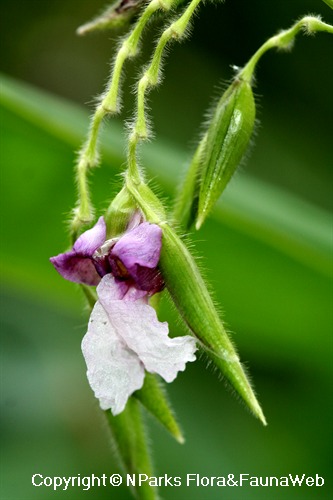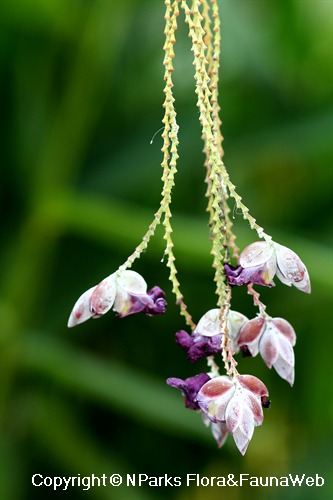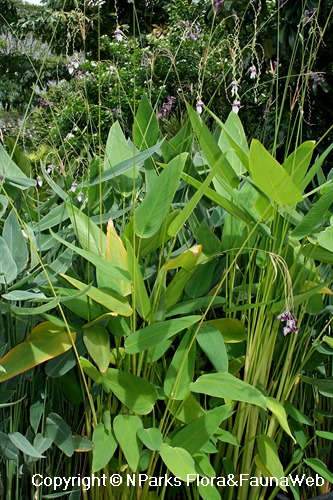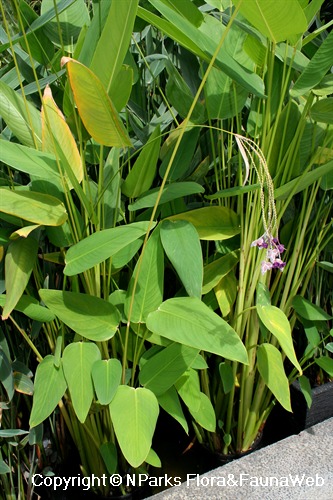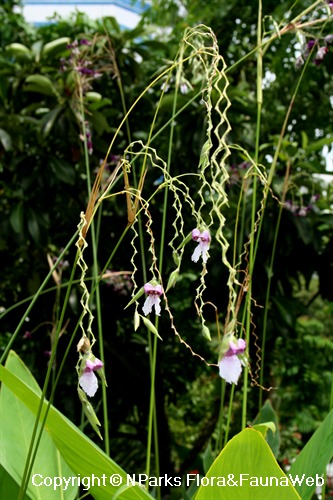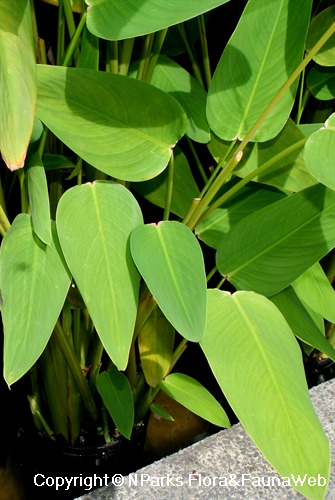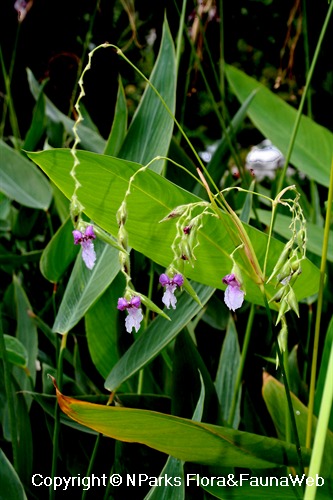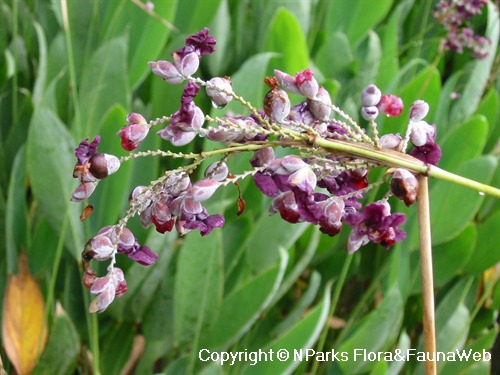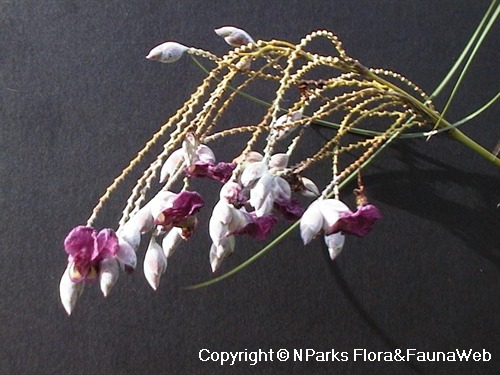
Back
Thalia geniculata L.
| Family Name: | Marantaceae |
| Synonyms: | Ataenidia , Ataenidia |
| Common Name: | Swamp Lily, Water Canna, Alligator Flag |
Name
Classifications and Characteristics
| Plant Division | Angiosperms (Flowering Seed Plants) (Monocotyledon) |
|---|---|
| Plant Growth Form | Aquatic & Hydrophyte (Emergent Aquatic, Waterside / Marginal), Herbaceous Plant |
| Lifespan (in Singapore) | Perennial |
| Mode of Nutrition | Autotrophic |
Biogeography
| Native Distribution | Central Africa, United States, Mexico, Central America, South America |
|---|---|
| Native Habitat | Terrestrial (Riverine), Aquatic (Freshwater Pond / Lake / River) |
| Preferred Climate Zone | Tropical |
| Local Conservation Status | Non-native |
Description and Ethnobotany
| Growth Form | Emergent aquatic plant. |
|---|---|
| Roots | The root system is well-developed and extensively intertwined. |
| Foliage | Large leaves are broadly lanceolate, having a rounded base and a pointed apex (> 1 m long). The leaf blade is held by a long, smooth, green or red-purple petiole. |
| Stems | It has a thick rhizome (underground horizontal stem). |
| Flowers | Paired flowers are suspended from a zigzag-shaped inflorescence stalk. Small, purple flowers (2 cm long) are composed of 3 petals and have an irregular shape. A white, petal-like bract hangs below the flowers. |
| Fruit | Fruits are known as utricles, containing a single brown to black seed. |
| Habitat | Naturally occurs in wetlands. |
| Similar | This species resembles Thalia dealbata, but it has larger leaves (sometimes more than 1 m long) that are more narrow and flat, as well as slightly larger flowers that are borne by a taller inflorescence stalk. Unlike T. dealbata, the leaf is less green without a powdery white surface. |
| Associated Fauna | Provides food and shelter for aquatic birds. |
| Etymology | The common name Alligator Flag is derived from its use in spotting alligators. The unexpected movement of the leaves is sometimes a sign that an alligator is swimming below. |
Landscaping Features
| Desirable Plant Features | Ornamental Flowers, Ornamental Foliage |
|---|---|
| Landscape Uses | Riverine, Container Planting, Marsh / Bog |
| Thematic Landscaping | Water Garden, Naturalistic Garden, Marsh Garden |
Plant Care and Propagation
| Light Preference | Full Sun |
|---|---|
| Water Preference | Lots of Water |
| Plant Growth Rate | Moderate |
| Rootzone Tolerance | Fertile Loamy Soils, Waterlogged Soils (Drains Site) |
| Maintenance Requirements | Moderate |
| Propagation Method | Storage Organ (Rhizome), Division, Seed |
Foliar
| Foliage Retention | Evergreen |
|---|---|
| Mature Foliage Colour(s) | Green |
| Mature Foliage Texture(s) | Smooth, Glossy / Shiny |
| Foliar Type | Simple / Unifoliate |
| Foliar Attachment to Stem | Petiolate |
| Foliar Shape(s) | Non-Palm Foliage (Lanceolate) |
| Foliar Venation | Parallel |
| Foliar Margin | Entire |
| Foliar Apex - Tip | Acute |
| Foliar Base | Rounded / Obtuse |
| Leaf Area Index (LAI) for Green Plot Ratio | 3.5 (Shrub & Groundcover - Monocot) |
Non - Foliar and Storage
| Stem Type & Modification | Acaulescent |
|---|---|
| Root Type | Underground (Fibrous Root) |
| Specialised Storage Organ(s) | Underground (Rhizome) |
Floral (Angiosperm)
| Flower & Plant Sexuality | Bisexual Flowers |
| Flower Colour(s) | Purple, White |
|---|---|
| Flower Grouping | Cluster / Inflorescence |
| Flower Location | Terminal |
| Flower Symmetry | Bilateral |
| Flowering Period | Free-Flowering |
| Flowering Habit | Polycarpic |
| Inflorescence Type Remarks | Paired |
Fruit, Seed and Spore
| Mature Fruit Colour(s) | Black, Brown |
|---|---|
| Fruit Classification | Simple Fruit |
| Fruit Type | Indehiscent Dry Fruit , Utricle |
Image Repository
Others
| Master ID | 1210 |
|---|---|
| Species ID | 2503 |
| Flora Disclaimer | The information in this website has been compiled from reliable sources, such as reference works on medicinal plants. It is not a substitute for medical advice or treatment and NParks does not purport to provide any medical advice. Readers should always consult his/her physician before using or consuming a plant for medicinal purposes. |

